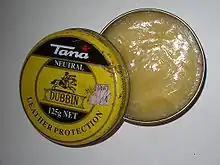Dubbin
Dubbin (also known as “dubbing” in the USA) is a greasy or waxy product used to soften, condition, and waterproof leather. It has been used since medieval times to waterproof and soften leather goods.[1] It differs from saddle soap used to clean and lightly condition leather, or shoe polish, which is used to impart shine and colour to it.

A tin of dubbin
It consists primarily of various waxes and oils. Commercial dubbin contains petroleum jelly (petrolatum), paraffin wax, neatsfoot oil, and naphtha (C10-12 alkane/cycloalkane),[2]. More traditional dubbin can be made with beeswax; fish oil; and lard,[3].
The name dubbin is a contraction of the gerund dubbing, describing the action of applying the wax to leather.[4]
References
- Citations
- Waterer, John William (1981). Leather and the warrior : an account of the importance of leather to the fighting man from the time of the ancient Greeks to World War II. Northampton, England: The Museum of Leathercraft. p. 61. ISBN 9780950418216.
- "Kiwi Dubbin Neutral". Archived from the original on 15 September 2023.
- "Mad Madam Mel: A recipe for Dubbin". madmadammel.com. Retrieved 2 September 2016.
- "dub1". askoxford.com. Archived from the original on 23 September 2004. Retrieved 15 April 2010.
- Other references
- - Material Safety Data Sheet - Joseph Lyddy dubbin.
- - Opportunities for industry and the safe investment of capital (1859) Rothman, E., Lippincott, USA
- Jarell, T.D., Holman, H.P., (1923) Effects of Treating Materials and Outdoor Exposure upon Water Resistance and Tensile Strength of Cotton Duck, Industrial and Engineering Chemistry, Bureau of Chemistry, Washington.
- Norton, F.J., (1945) Waterproofing Treatments of Materials, Patent Number 2386259, Serial Number 452,885, United States Patent Office.
- Holman, H.P., Jarrell, T.D., (date unknown) The Effects of Waterproofing Materials and Outdoor Exposure upon the Tensile Strength of Cotton Yarn, Industrial and Engineering Chemistry, 15(3), US Department of Agriculture, Washington.
- Stewart, C.S., (1977) Factors Affecting the Cellulolytic Activity of Rumen Contents, Applied and Environmental Microbiology, pp. 497–502
This article is issued from Wikipedia. The text is licensed under Creative Commons - Attribution - Sharealike. Additional terms may apply for the media files.